C/2007 F1 was discovered as part of the Lowell Observatory Near Earth Object Search (LONEOS). The actual discovery was made by B.A.Skiff using the facilities 58cm Schmidt Camera and a CCD. The preliminary orbit indicated that this comet would become a telescopic object in late October, with a perihelion date of October 28th. However subsequent observations indicate that 2007 F1 is set to become significantly brighter than initially expected. There is now a reasonable chance that this comet may even reach magnitude +3. This report includes all my visual observations of this comet in the order in which I found it throughout its apparition complete with sketches and images.
 |
Tonight I made my first visual observation of C/2007 F1 LONEOS in the NW evening sky from 20.21-20.55 BST using a 8.5" F/7 dobsonian reflector with 32mm 1.25" eyepiece. The comet is currently passing eastward through Coma Berenices and tonight it could be found within the naked eye open cluster known as Melotte 111 (or Collinder 256). I first located the cluster in 10x50mm binoculars then guided the scope in that direction and began sweeping above the treetops in a vertical fashion when I found the comet within five minutes and was surprised just how easy it was.
I estimated the coma at 3' in dia and a D.C value of 6. The coma is circular and compact sporting a white central region. I thought I could detect a hint of green colour during moments of good seeing. No tail was observed although I did see a stellar false nucleus in the 9.7mm ocular. I agree with the current magnitude estimates which place the comet at + 7.5.
I tried for it with the 10x50s (code= B50) without success. I watched it set behind treetops along with a bright field star which was quite close to the comet. I took several images also. I can tell from the physical appearance of LONEOS that this is going to be a very nice comet! This my 40th comet and one of the first sightings from Ireland. Cold, calm, dry, dark sky T=7+, S=5. Beautiful night with outstanding Milky Way in Cygnus and Aquila. With B50 I observed the TCrB field and RCrB which was currently in a long duration dimming event and invisible with the naked eye. I intend on observing this comet on every clear night until it disappears.
Seen it again tonight through a small clear gap in a slow moving section of Alto Cumulus which covered the western sky. I picked up the comet at 21.16 BST when it was only 5 degrees above the NW horizon in a hazy sky with poor transparency. It shared the same telescopic field with treetops. It set after five minutes of observation. The coma looked bright, compact, moderately condensed (DC: 6), brighter toward the centre with a stellar false nucleus which was easier to see tonight. No tail. Coma was a grey-green tone and I thought it looked larger tonight in the 3.5' - 4' range. Looked nice within the heart of open cluster Melotte 111. I thought I glimpsed it in B50?.
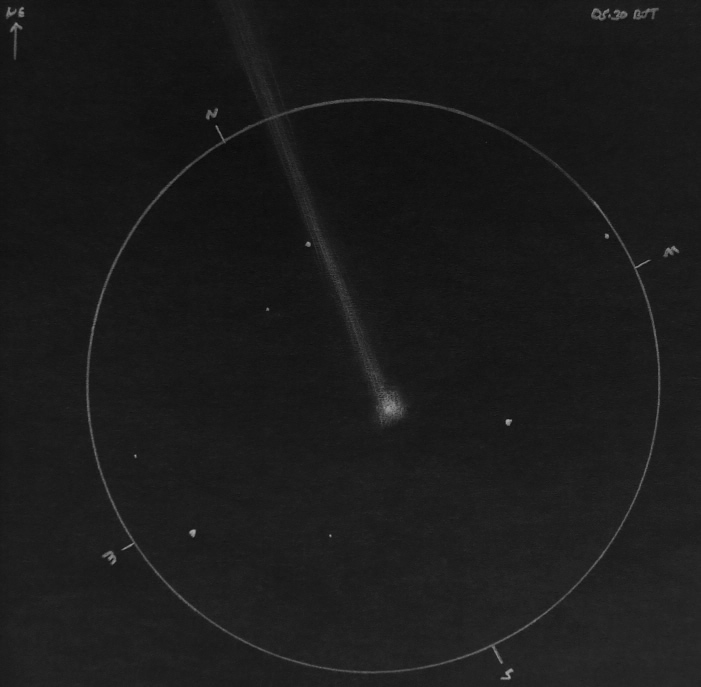 |
Before dawn I made my 2nd visual observation of C/2007 F1 LONEOS within 12 hours. In the pre dawn sky it was well placed in the NE within Melotte 111 in Coma Berenices. I observed it from 05.30 - 06.08 BST with the 8.5" F/7 reflector. I noticed that the pre dawn period is much more favorable than the corresponding evening apparition with the comet clearing rooftops at the beginning of the session greater than 10 degrees in latitude. By the end of session the comet was between 15 - 20 degrees high. For much of the session it was visible in a dark sky!.
Coma was grey-green with white central region sporting a vivid stellar false nucleus. Coma is compact and well condensed. I also made my first observation of a blue plasma tail extending for no less than 1 degree to the north even in light haze. At one stage I suspected the tail was greater than 2 degrees long however I cannot confirm this. Comet is looking very healthy!. Mag: + 7.5 D.C:6 Dia: 4' - not seen in B50. Also picked up the central coma on an image at ISO800/15 sec exp at F/3.2.
T=4-5, S= 4. With B50 I observed M31, M32, M110, M33, M32, Double cluster, Chi Cygni, TCrB field, RCrB, and M15. Milky Way clearly visible. With the 8.5" I observed M31, M32, M110, M33, M76, M34, NGC404. My dogs Benson and Drew where outside with me during this period sniffing around the telescope base and giving me the paw. I am delighted to have seen the comet for two days in a row now. Despite having a terrible migraine this evening I felt delighted!. I got the above sketch published on spaceweather.com.
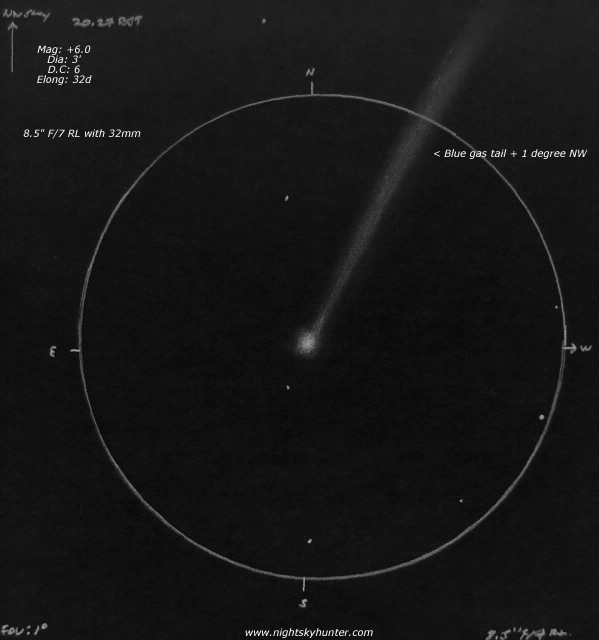 |
I made a visual observation of C/2007 FI LONEOS during the evening from 20.27 - 20.39 BST despite a very poor sky. The western sky was covered with dense haze with the transparency ranging from 1 to 4 at best. Slow moving light cumulus clouds revealed only narrow clear horizontal strips. I began seeping for the comet in bright twilight at 19.50 and after much frustration picked it up in the 8.5" low in the NW within Coma Berenices this time located further to the east of Melotte 111. I noted that the comet IS visible in a dark sky despite being only 32 degrees in elongation from the Sun.
The coma was very striking with a brilliant white and quite intense central condensation which looked much more active since my previous observation on the 4th. The inner coma looks very energetic and a stellar false nucleus could clearly be seen in the 9.7mm. The eastern side of the coma looked wider than the west. The coma had a very compact well condensed profile, spherical in shape with a dominating white colour. I did not see any green tonight. The coma looks very similar to a unresolved globular cluster. Imagine Messier 15 without the mottled texture.
Once the sky was completely dark the tail seemed to 'switch on'. I could see the faint blue gas tail pointing to the NW for at least 1 degree. The tail seemed to widen with distance from the coma. Perhaps a faint dust tail is superimposed on the gas?. Spotted one blue streamer running from the coma into the tail.
Comet soon set behind treetops. Seen LONEOS fairly easily in B50 binoculars once I knew where to look. The telrad on the scope really helped here. Also tried for a naked eye observation without success.
Mag: +6.7? (perhaps brighter), Dia: 3' D.C:6. This was part of observing session 2570M. Cool, wet, dew on ground, tube and telrad, calm, barely detectable SWly breeze, dark sky, T=5-6, S=5, patchy haze, slow moving sections of altocumulus. Waning crescent Moon in western Gemini 30' from M35 with very dark earthshine. Session ended at 06.15 BST after a quick sweep through morning twilight with B50 for bright new comets.
Managed to glimpse comet LONEOS this evening at 20.17 BST in a very unsettled sky. Lots of dark cumulus cells passing over delivering showers, sleet, hail and torrential rain at one stage. Any clear sky present was in short supply and very short lived. I spotted a hazy clearing in the northwest and swept through it with the 8.5" and found the comet to the west of Arcturus above treetops. During my brief observation it was clear that LONEOS is very bright with a larger coma and intense white central condensation. The tail section near the coma also was much brighter. I even thought I glimpsed a second tail but I am uncertain about this. It was extremely easy to see in B50 and I even thought I glimpsed it with the naked eye but this is not confirmed. With a clear sky forecast for later tonight I hope to make a better observation before dawn. T=8, dark sky, cool, calm, wet. Tried to sweep up new comet C/2007 T1 Mc Naught in the SW sky in southern Ophiuchus however the sky was too hazy.
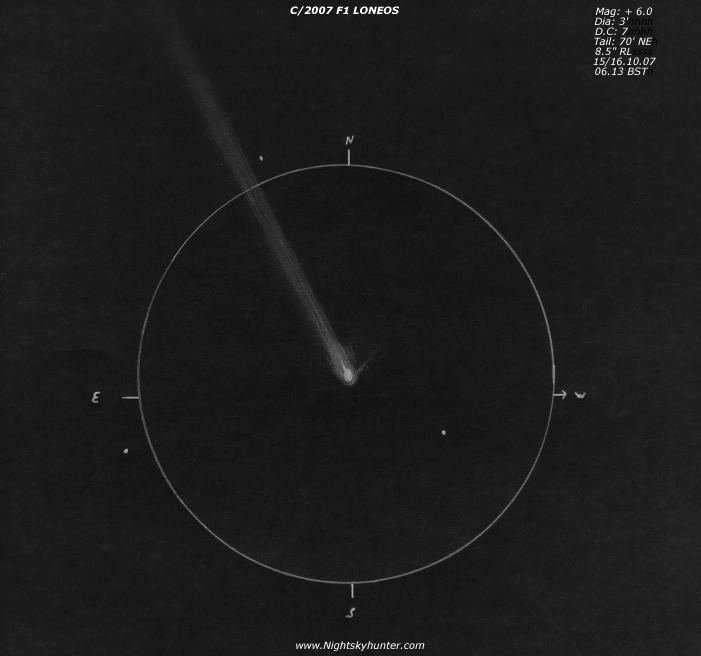 |
I swept up C/2007 F1 LONEOS during the course of my comet hunting before dawn this morning at 06.13 BST. The comet was very low in the NE morning twilight within Coma Berenices near the Bootes border not far north of Arcturus (which was hidden by obstructions) in bright twilight. It was so low that I reckon any future pre dawn observations from here are numbered. The comet shared the same FOV as a house rooftop and was very impressive despite the hazy sky.
The intense white central condensation (CC) was striking in appearance as a large white disk. The gorgeous green coma was tightly wrapped around the CC and elongated in the direction away from the Sun as it blended with the tail. The coma is compact, very well condensed with sharp edges and was parabolic in shape in the solar direction. The effect of the solar wind on the comet is very obvious visually. A narrow tear drop shaped spine extended from the coma into the tail and I seen a thin linear extention leaving the coma to the NW - possibly the leading edge of a faint dust tail?.
The ion tail itself was a subtle blue colour and extended for 1 degree 10' to the NW, very straight and sporting several fine streamers some of which could be seen fanning out from the coma. The comet was easy in B50 and I seen it several times with the naked eye using averted vision. This is my 5th observation of LONEOS and the second within an 11 hour period so thank goodness for the timely clear skies!
Mag: +6.0 Dia: 3' D.C: 7. Calm, dry, quiet, cold, wet, light dew, dark sky, T= 7+, mostly clear sky with periodic cirrostratus heading NE producing sections of hazy sky low down. Heavier cloud produced short lived sleet showers forcing me to take shelter in the backdoor until it passed. I did a naked eye dome search and observed M51, M42, Orion's Belt, Mars + M35 (in same field) Melotte 111, M44 and M41 in B50. Spent some time comet hunting with the 8.5" in the NE and E pre dawn sky through sections of Uma, Lynx, Cancer, N. Hydra, Leo, Canes Venatici. Swept up Venus, Saturn (rings nearing edge one), M67, M44, M3, NGC2903, and NGC5033. Seen a long duration Venus Corona followed by north then south pointing Venus pillars. Seen Zodiacal band and several nice orange-red meteors including one which shot through the field of B50. Great all night session...number 2580M. This was my best observation of LONEOS to date and my 6th sighting.
Managed to find the comet early this evening in bright twilight and watched it grow as the sky darkened. Despite a fairly good sky, lights from houses, cars, smoke and developing haze made it a poor observation. I seen the first section of tail and several streamers. The coma looked white tonight. Picked it up in B50 and took a few images which I have yet to check. I later lost it behind trees. I examined the coma at high power using the 9.7mm, seen the stellar false nucleus but the seeing was poor. This was one of the better images showing LONEOS, Arcturus and Messier 3 all in the same field. A faint tail can be seen for a considerable distance to the north. Taken with a Fujifilm S5600 5.1MP at ISO800/15 sec exp at F/3.2. My friend John Mc Connell from Maghaberry made his first visual observation of the comet tonight and Paul Evans from Larne got several good images showing a faint tail. I tried for C/2007 T1 Mc Naught again but the sky was unusable this evening. I was quite furious with the neighbours for unneeded outdoor lights and open curtains which caused the tail on LONEOS to vanish in the eyepiece.
Cold, calm, hazy, dry, quiet, T= 5-7, very sharp air with developing frost, sky almost 100% clear. Since Halloween was approaching several fireworks where exploding in the sky with red colours and loud detonations. I took advantage of the situation and took an exposure from the back garden and I caught one by pure chance! - IMAGE. Jonathan Shanklin from the BAA informed me via email that the rate of brightening of LONEOS has slowed down and he expected the comet to peak at mag +5.5 although he would be delighted to be proved wrong. I can expect to loose the comet around Oct 27th. However if an outburst occurred this could turn into a wonderful little comet so I was keen to keep watching this new visitor.
 |
Got up this morning at 04.30 BST and had a great pre dawn comet hunt for 1.5 hours then I waited for LONEOS to rise. I caught it as it cleared the neighbour's roof at 06.40 BST in a very intense bright blue twilight sky to the north of Arcturus. It was so low and close to the Sun here that I suspect this will either be my last or second last morning observation of the comet. The sky was so bright that the outer coma was gone leaving only a highly condensed coma only 1.5' in dia at D.C: 8 with a stellar false nucleus and narrow spine. I seen several radial features within the coma. The blue ion tail was very straight and pointing NE for 1 degree and seemed to fan out with distance away from the coma. I am amazed how well that coma and tail are holding up against such a bright sky which reminded me of C/2001 V1 NEAT. It would be interesting to see how long this comet could be followed. Session ended at 07.00 BST. Mag: + 6.0 Dia: 1.5' D.C: 7/. Elongation: 30 deg.
Very cold, calm, dark sky, dew, T= 5-6, S= 4. I only had LONEOS in view for 9 minutes and retired at 06.49 BST. This is my second observation of the comet in 12 hours and for the 2nd night in a row!.
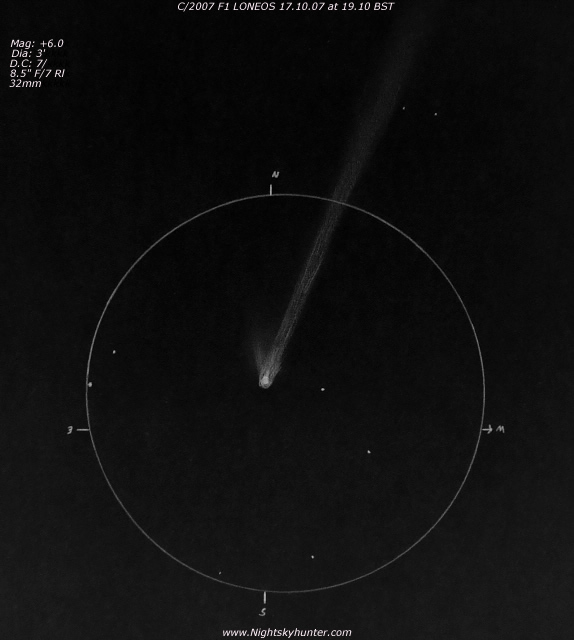 |
Despite a poor sky with cloud, haze and chimney smoke along with a developing frost the sky cleared from the west and I found the comet extremely quickly at 19.10 BST to the west and slightly south of Arcturus in the darkening evening twilight.
The coma was thin, compact, very well condensed with clearly defined edges where the coma meets the sky. It was wrapped tightly around a large white disk-like central condensation with a tear drop appendage from which a long spine ran into the tail. The coma was elongated away from the Sun and sported several fanning streamers similar in profile to a 'shuttle cock'. The coma was a white-grey tone however no green could be seen.
The ion tail was blue, very straight, extending for 1 degree to the W of N and broadened with distance away from the Sun. Delicate long blue streamers could be glimpsed in fleeting moments of good clarity. I suspect the tail is MUCH longer than this. I was able to confirm something I have suspected since the morning of the 16th - a faint dust tail visible to the E of N leaving at a shallow angle from the coma perhaps 5' long. The leading sun ward edge of this tail is the brightest component. It will be interesting to watch its development. This is my best evening view of the comet to date.
Lost the comet to clouds so I did a little deep sky work then watched the waxing crescent Moon with earthshine set over the mountains with compact orange corona and long but faint pillar. For icing on the cake a V-shaped formation of geese flow overhead calling as they headed to the NE with bellies and wings lit orange from the town lights!. Mag+ 6.0 Dia: 3' D.C: 7/. Very cold evening with developing frost, dry, calm with broken stratocumulus, T= 5+, S= 3, haze, light cloud, drifting smoke, reflecting sodium lights. With the 8.5" I observed M13, M92, NGC Glob in Hercules, M57, M56, Beta Cygni, M71, M27, M15, M31, M32 and M110 before the sky clouded over. This is my 9th observation of the comet. Session 2385E was very successful.
After several nights of cloud and showers a weak front passed away today leaving clear skies in its wake however the signs were not good with hazy sunshine and crepuscular rays indicating the sky was not as clear as I would want. After sunset the waxing gibbous Moon rose in the east within the pink 'Belt Of Venus' with Earth's shadow below and with it came the arrival of very dense murk and haze which looked like a grey-green wall due to the Moon's illumination. I felt sure I would never see the comet this evening but I set up my scope in the back garden to cool down anyway and by 19.10 I was ready.
I could see Arcturus in the west but his mag + 3.75 naked eye companion (Zeta) to the east was not seen which was not a good omen. Using B50 was worthless so feeling blind I simply guided the scope into the murky section of sky between my neigbour's two houses and began a slow vertical sweep in the same fashion as I would be when searching for new comets. At 19.23 BST I found the comet!.
Despite the horrible sky the coma was extremely bright and very small with sharp well defined edges and showing off a very vivid green colour. At centre was a bright white stellar central condensation with slight diameter with a tadpole-like spine of long length embedded within the type I ion tail which itself was colourless and extending north for 1 degree 10 arc minutes. The tail broadened rapidly as it left the coma and consisted of multiple components. Many very long bright blue streamers could be seen within. A faint wedge shaped grey type II dust tail could be seen for 5 arc minutes to the NE. The ion tail was superimposed on the northern section of this fanning tail. Comet was low in the twilight only 23 degrees from the Sun and some 15 degrees to the SE of Arcturus within Bootes and nearing the border of Virgo.
The comet looked in great shape but could not be seen with B50 due to the murk. I lost the comet as it sank into the atmospheric quick sand in the west. On a better night I suspect this would be a great sight!. I took 5-6 images at ISO800/15 sec exp at various optical zoom and managed to pick up the stellar condensation however the images are not good enough for publication.
I am hoping for a better view tommorow as clear skies are forecast but I am delighted to have seen LONEOS again making this my 10th observation. Mag: + 5.8? Dia: 2' D.C: 8.
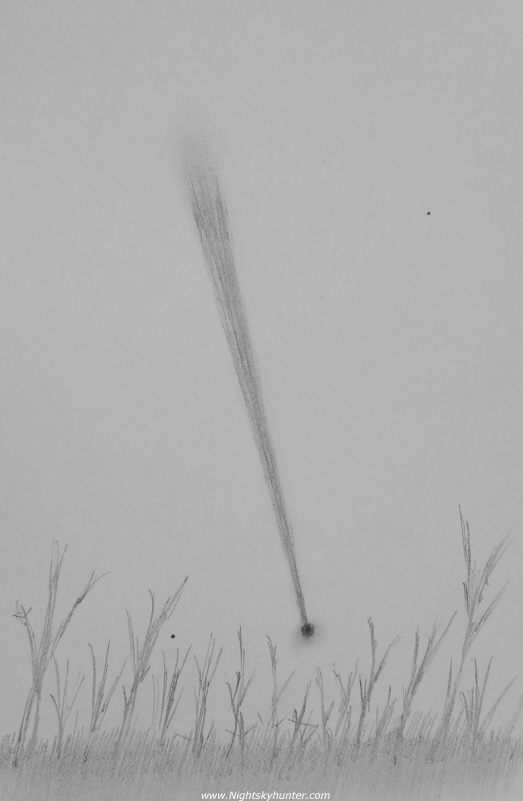 |
On this crisp evening I decided to focus my attention on C/2007 F1 LONEOS which is due to vanish from UK skies on Oct 27th. I have not seen the comet for some time and despite several evenings of unsuccessful attempts due to poor sky conditions I had considered the comet gone. This evening while conducting a vertical search through the western twilight with a 8.5" F/7 reflector with 32mm I swept up LONEOS at 19.34 BST. The coma was of moderate size and well condensed, circular in shape, grey-white in colour with bright disk-like central condensation. The coma was viewed through gaps between distant tree branches which shared the telescopic field. What caught my attention was the wonderful colourless straight Ion tail extending to the E of N for a minimum distance of 2 degrees although I suspected it to be much longer!. I followed the tail across the sky with the telescope and could see many streamers. The tail was very bright and looked like a beam of light.
After several minutes the coma set leaving a wonderful search light beam extending up from the tree tops!. It looked like a minature 'Great Comet'!. Also seen in B50. This is a very beautiful comet and one which I think is currently under observed by many people which is a shame. I had LONEOS in view for 9 minutes before it set but before it did I glanced to the NE sky and seen 17P/ Holmes with the naked eye - two bright comets visible at the same time!. My 11th observation.
Mag: 5.0 Dia: 3' D.C:7 Tail: + 2 degrees. Two sketches. One original and another inverted.
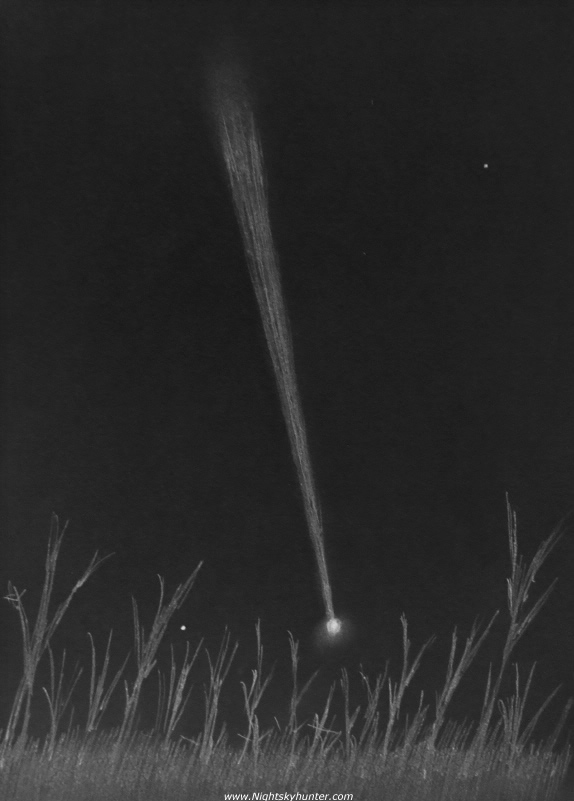 |
This was my very last observation of comet LONEOS. It now has dropped below the obstructions on my western horizon as it approached perihelion days later. It now resides in bright twilight less than 20 degrees above the Sun and with each advancing day it marches further south for those lucky and keen comet observers who reside in more southerly latitudes. I really enjoyed following this comet each clear night as it gradually unfurled a lovely ion tail followed by one of the dust variety. The comet's departure has announced an exciting time for comets. 17P/ Holmes is now taking centre stage as the main star attraction then for Christmas and New Year 8P/ Tuttle will be begging for attention, and you never never know...perhaps Holmes will still be visible at this time and we will have two naked eye comets visible at the same time!. Sound too optimistic? - well if there is one thing I have learned about comets and the night sky it's to expect the unexpected. I can see a period of very busy days and nights ahead!
Martin Mc Kenna